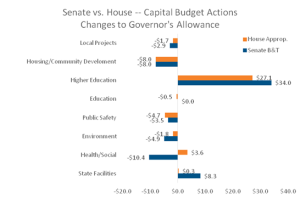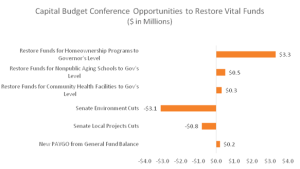Maryland lawmakers negotiating a final state budget for building projects should restore more than $5 million they have proposed to cut from affordable housing, community health facilities and renovations for non-public schools. The funding could come from cuts elsewhere in the budget and reserves.
As the General Assembly makes final decisions on the state’s operating budget, which pays for education and most other state services, legislative negotiators are also working out differences in the Senate and House versions of the capital budget, which funds things like building projects. Using the example of a family budget, monthly bills for food, gas, utilities and health care would correspond to the state’s operating budget. The capital budget would be equivalent to a family taking out a loan to buy or build a new house or to put an addition on its home. Most of the capital budget — about 78 percent of funding in the upcoming 2015 fiscal year — is financed with debt. And just as a bank will usually require a family to make a cash down payment for a mortgage, the state is obliged to use upfront cash for about 22 percent of the FY 2015 capital budget, a concept known as pay-as-you-go, or PAYGO.
Unfortunately, both the House and the Senate versions of the capital budget currently cut $4.5 million from affordable housing programs that help working families afford down payments on a new home or to pay for money-saving energy efficiency and weatherization upgrades. Both plans would also cut $300,000 from community health facilities, which provide Women, Infants, and Children (WIC) nutrition services and crucial access to preventive, dental, and other health care in neighborhoods throughout the state. The most recent legislative version of the capital budget, the House plan, also cuts $500,000 from a program that helps parochial and other non-public schools, which often serve low-income neighborhoods, pay for building renovation and upgrades. Fortunately, lawmakers have the opportunity to restore funding for these vital supports for working families and still balance the capital budget.
Source: Department of Legislative Services; Note: See Exhibit 4, pages 11-20
Source: Senate Budget & Tax Committee and House Appropriations Committee
The legislature could pay for these restored funds by adopting the Senate version of cuts to environment projects and local projects. In addition, the legislature could transfer $200,000 of the closing general fund balance in the operating budget to the capital budget and use that as PAYGO funding to fully restore capital funds needed for education, health and affordable housing projects.
Source: Senate Budget & Tax Committee and House Appropriations Committee
Below is a more detailed description of what is funded by the capital budget currently being considered by the General Assembly. Check back here for more information on upcoming legislative action on the operating and capital budgets and the impact on valuable and proven services and programs.
Capital Budget Details
· Funding for environmental projects and programs to improve environmental quality totals $485 million, including:
o $130 million for water quality projects
tyle=”font-family: ‘Courier New’;”>o $102 million for nutrient removal programs
o $84 million for land preservation programs
· Higher education facilities and projects receive $374 million, including:
o $289.1 million for state colleges and universities
o $65.4 million for community colleges
· $308 million goes to schools and other K-12 facilities, including $298.2 million for the Public School Construction Program
· Housing and community development project funding total $131 million in the Governor’s capital budget including:
o $30 million for rental housing programs
o $14 million for homeownership programs
o $1.5 million for emergency shelter grants.
· $89 million in funds in the Governor’s capital plan pays for health or social projects, including $30 million for the Price George’s Hospital System.
· Public safety projects are funded at $43.5 million, including:
o $15.3 million for a new minimum security facility at Dorsey Run
o $12.5 million to the State Police to replace helicopters and for a new flight training center
· Funding for local projects in the Governor’s plan total $55.1 million and included:
· Both the House and Senate allocate an additional $7.5 million for local projects allocated at the discretion of the legislature, including:
· Other legislative-funded local projects include:



